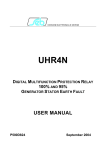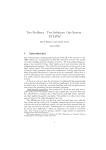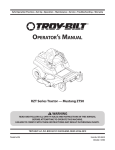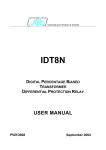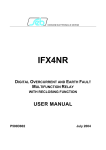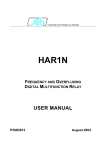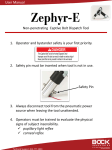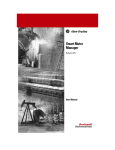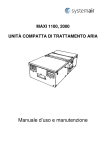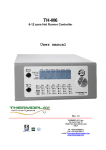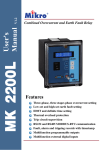Download USER MANUAL - seb barlassina
Transcript
DIVISIONE ELETTRONICA E SISTEMI IDG8N DIGITAL PERCENTAGE BIASED GENERATOR DIFFERENTIAL PROTECTION RELAY USER MANUAL P501D806 September 2004 SEB Divisione Elettronica e Sistemi INDEX INDEX 1 2 3 4 5 6 7 8 GENERAL CHARACTERISTICS..................................................................................1 1.1 Operation of the differential thresholds..................................................................3 1.2 Generator differential protection (ANSI 87G).........................................................5 1.3 Differential earth fault protection (ANSI 64Ss) .......................................................6 FRONT PANEL KEYS ..................................................................................................7 FRONT PANEL LED SIGNALLINGS............................................................................8 PROGRAMMING AND TEST .......................................................................................9 4.1 How to program the protection relay......................................................................9 4.2 How to modify a visualized parameter.................................................................10 4.3 Reset ...................................................................................................................10 4.4 Test of output relays ............................................................................................11 DISPLAY AND PROGRAMMING ...............................................................................12 5.1 Standard display..................................................................................................12 5.2 Visualization structure .........................................................................................13 5.3 Address and time (fig. 1) .....................................................................................16 5.4 Function selection (fig. 1) ....................................................................................17 5.5 Nominal values set-up (fig. 2) ..............................................................................17 5.6 Thresholds and time delays set-up (fig. 2)...........................................................19 5.6.1 Percentage biased differential thresholds (Id>, Ido>) (fig. 2) ........................19 5.6.2 Second differential thresholds (Id>>, Ido>>) (fig. 2) .....................................21 5.7 Output relays programming (fig. 2) ......................................................................22 5.8 Digital inputs function programming (fig. 2) .........................................................23 5.9 Parameter values visualization (fig. 3).................................................................25 5.10 Events (fig. 3) ......................................................................................................26 5.11 Trips counters (fig. 3)...........................................................................................29 INSTALLATION ..........................................................................................................30 6.1 Supplied kit ..........................................................................................................30 6.2 Cabling ................................................................................................................31 6.3 Relays R3 and R4 - Signaling / Command set-up ...............................................36 6.4 RS485 serial communication port........................................................................36 TECHNICAL CHARACTERISTICS.............................................................................37 TABLE ........................................................................................................................38 Information printed in this manual subject to change without prior notice. This manual must not be reproduced in whole or in part, in any form or by any means without the express written permission of SEB Divisione Elettronica e Sistemi. SEB Divisione Elettronica e Sistemi 1 GENERAL CHARACTERISTICS GENERAL CHARACTERISTICS The protection relay IDG8N performs function as three-poles percentage biased generator differential protection relay (ANSI 87G) and/or selective earth fault protection relay (ANSI 64Ss); the user can select one of the functions listed in the table below. FUNCTIONS Three-poles percentage generators or motors biased ANSI differential protection for Selective earth fault protection (percentage biased differential) 87G 64Ss All the set-up and measured parameters can be visualized on the front panel display and transmitted on the RS485 communication serial port. THRESHOLDS - the following thresholds are available: • • • • 1 differential percentage biased threshold (two branches) 1 absolute value differential threshold 1 earth-fault differential percentage biased threshold (two branches) 1 absolute value earth-fault differential threshold The tripping characteristic for each threshold is presented in figure A. The available settings for each threshold are listed in Table A. TRIP DELAYS - All the thresholds are time definite and each threshold time delay TI can be combined with an additional time delay (TA); the additional time delay is added to time delay TI. The additional time delay activation is controlled by the digital inputs. The available settings for each timers are listed in Table A. OUTPUT RELAYS - the IDG8N controls 4 output relays (named R1, R2, R3 and R4); these relays can be programmed to be activated on START or TRIP conditions of one or more thresholds. START instantaneous activation of the output relay when at least one of the measured current or parameter exceeds the programmed threshold value TRIP activation of the output relay when the programmed time delay (TI or TI+TA) related to a threshold expires. The quiescent state of each single relay R1, R2, R3 and R4 can be programmed as normally energized (ON) or normally de-energized (OFF). An additional relay R5 (normally energized) is controlled by the self-diagnosis routines to report detected fault conditions. Related to each threshold, partial and total counters of TRIP conditions are available. 1 SEB Divisione Elettronica e Sistemi GENERAL CHARACTERISTICS DIGITAL INPUTS - there are available 6 digital inputs to activate the following functions (when enabled by the programmed set-up): • additional time delay (related to one or more thresholds) • on/off thresholds • STATUS function (recording of measures on external event) • pilot wire fault monitoring (only digital input DIG2) For each digital input can be programmed the condition that activates the related functions: HI voltage = LO voltage = > 20 V dc / ac 0 ÷ 10 V dc / ac The digital input acquisition is valid when the voltage value stays in the range HI or LO for at least 40 ms. DISPLAY OF MEASURES - the user can select the continuous display of a measured differential current or of a stabilizing current (primary values or relative values); all the measured currents can be transmitted to an external controller through the RS485 port. EVENTS - information related to the last 8 events (TRIP or STATUS) are recorded in the EEPROM memory. Information includes the threshold set-up and activated relays (TRIP event only), the measured currents, the digital input status, date and time of the event. SELF-DIAGNOSIS - the software includes a non stop monitoring module that controls the functionality of all hardware and software resources of the protection relay. Detected fault conditions are reported by: • diagnostic message on the display • glow of a red LED on front panel • R5 output relay drop-off The fault condition signaling stays until faults are pointed out by the monitoring module; during this condition the protection functions are suspended to avoid unsuitable tripping. STATUS FUNCTION - when the STATUS function is activated by one of the digital input (when programmed) the protection relay memorizes information related to measured currents and digital input status (see par. 5.10 - EVENTS). The recorded information allows an analysis of trip causes in co-operative protection relays systems. PILOT WIRE FAULT MONITORING - when the function is programmed, the digital input DIG2 is used to control the correct functionality of the pilot wire. Digital input DIG2 is always expected to be complementary of DIG1 input (HI-LO or LO-HI) to identify faults on pilot wire. 2 SEB Divisione Elettronica e Sistemi GENERAL CHARACTERISTICS The fault condition is reported as detected by the self-diagnosis module but the protection functions are not suspended; only the functions related to DIG1 digital input are suspended as the DIG1 status cannot be longer considered as true. The fault condition is reported when DIG1 and DIG2 signals are not complementary for more then 100 ms. REMOTE COMMUNICATION - the opto-insulated serial port RS485 can communicate with a personal computer or a remote control and monitoring system equipped with an RS485 interface or with a standard RS485/RS232 converter. It is possible to select the communication standard between STANDARD (ASCII 7 bit Seb protocol) or MODBUS (ASCII mode, SLAVE). All the set-up and measured parameters can be transmitted on the RS485 communication serial port; when communication is active (LED REMOTE glows), the operator on front panel can visualize the relay set-up but changes of parameters are disabled (ENTER and buttons disabled). 1.1 Operation of the differential thresholds The IDG8N relay performs functions as percentage biased differential protection relay; the tripping characteristic for the ANSI 87G function (equivalent characteristic applies to ANSI 64Ss) is presented in figure A. A differential protection relay operates on the principle of current comparison and with a healthy protected object the current leaving is the same as that which entered it. Any measured current difference is a clear indication of a fault condition within the protected zone. The digital percentage biased generator differential relay can be used to protect high voltage cables (maximum length about 1 km); it cannot be used as transformer differential protection relay and for this application please refer to IDT8N model (transformer differential protection relay). Id - differential current - vectorial difference between the input current and the output current of the protected object Id1 = I 1' − I 1'' Three differential current values are computed, one for each phase; the differential thresholds are verified for each differential current. Ia - stabilizing current - half-sum of the vectors of the input and output currents of the protected object used to stabilize the protection relay operations in presence of faults external to the protected zone. Ia1 = I 1' + I 1'' 2 3 SEB Divisione Elettronica e Sistemi GENERAL CHARACTERISTICS When short-circuit currents due to faults external to the protected zone are flowing through the protected object it is possible to have measured differential currents due to current transformer errors or saturation. The stabilizing current is used to stabilize the protection relay operation in these conditions. Differential thresholds Two differential thresholds are available: Id> percentage biased differential threshold Id>> second differential threshold (absolute value) The relay operates when: threshold Id>> Id the following disequation is verified ≥ Id >> threshold Id> ALL the following disequations are verified: Id ≥ Ib > Id ≥ (P1 ∗ Ia ) Id ≥ (P2 ∗ Ia − DI ) where: |Id| |Ia| Ib> P1, P2 DI module of the differential current module of the stabilizing current insensibility threshold slopes of the tripping characteristic intersection of the P2 straight line with Id/In axis The listed disequations define the operating characteristic as presented in figure A and they are verified with all the differential currents (and their stabilizing currents) related to phase currents (ANSI 87G) and earth current (ANSI 64Ss). The differential threshold Id>> and the second branch of the operating characteristic related to Id> threshold (slope P2) can be programmed ON/OFF. All the differential thresholds are definite time (0.02 ÷ 99.99 s) and each of them can be combined with an additional timer controlled by the digital inputs. The minimum activation time of the output relay is programmable in order to avoid short commands to switchgears when CT’s saturate. 4 SEB Divisione Elettronica e Sistemi GENERAL CHARACTERISTICS Id / In Ido / Ino Id >> Ido >> Zona di intervento P2 , P20 Operating zone Zona di non intervento Non operating zone P1 Ib > P10 Ibo > Ia / In Iao / Ino DI , DIo Operating characteristic - figure A 1.2 Generator differential protection (ANSI 87G) The protection relay IDG8N has been designed to provide three-poles percentage biased differential protection function to generators and motors; the operating characteristic reduces the sensibility to currents due to fault conditions outside the protected zone. The insertion of the protection relay is presented in figure 4. The CT’s installed on the starpoint side (I’) and on busbars side (I”) must have the same ratios and characteristics. 5 SEB Divisione Elettronica e Sistemi 1.3 GENERAL CHARACTERISTICS Differential earth fault protection (ANSI 64Ss) The protection relay IDG8N has been designed to provide differential protection against earth faults in the following applications: • selective protection against stator earth faults (restricted earth fault protection) for generators with earthed neutral point during operating with other generators on the same busbars • selective protection against earth fault on star connected windings of a transformer • earth fault protection on reactors The insertion of the protection relay is presented in figure 5; if connection to busbars is not carried out by cable, it can be used an Holmgreen connection of 3 CT’s. All the CT’s must have the same characteristics. 6 SEB Divisione Elettronica e Sistemi 2 FRONT PANEL KEYS FRONT PANEL KEYS The 5 push-buttons on the front panel allow to visualize all the protection parameters and to modify the protection set-up. right arrow down arrow ENTER programming session activation or parameter confirmation change or increment of the selected parameter RESET reset of the protection relay (rif. par. 4.3) VISUALIZATION OF PARAMETERS • all visualizations are circular and they can be displayed using the two arrow pushbuttons. • the structure of the visualizations and their contents are shown in Figures 1, 2 and 3. • when the sealable transparent front panel is installed only the arrow push-buttons and the RESET push-button are accessible to prevent unauthorized modification of the protection set-up. MODIFICATION OF PARAMETERS • remove the transparent sealable front panel to access ENTER and buttons. 7 push- SEB Divisione Elettronica e Sistemi 3 FRONT PANEL LED SIGNALLINGS FRONT PANEL LED SIGNALLINGS POWER (verde) ⊗ auxiliary supply available (red) ⊗ fault condition detected by SELF-DIAGNOSIS software or by PILOT WIRE FAULT MONITORING function REMOTE ⊗ communication session active on RS485 port FAIL (red) Id> (red) Id>> (red) Ido (red) ⊗ trip condition on Id> threshold (ANSI 87G) ⊗ trip condition on Id>> threshold (ANSI 87G) ⊗ trip condition on Ido> or Ido>> thresholds (ANSI 64Ss) The last trip condition (threshold indication) is also showed on front panel display; more information on trip condition are presented in the recorded EVENT (see par. 5.10). 8 SEB Divisione Elettronica e Sistemi 4 PROGRAMMING AND TEST PROGRAMMING AND TEST The protection relay is easily programmable following the instructions in the next paragraphs: • • HOW TO PROGRAM THE PROTECTION RELAY HOW TO MODIFY A VISUALIZED PARAMETER All parameters can be freely modified; the proper protection set- up as required by the plant management is submitted to the operator's judgment. 4.1 How to program the protection relay The programmable parameters are showed in Figures 1, 2 and 3 at the following references: B2 ÷ B7 C1 D1 ÷ D6 E1 ÷ E9 F1 ÷ F6 G1 ÷ G6 H1 ÷ H6 S1 ÷ S8 relay address (RS485) and date/time relay functions nominal values, contrast etc thresholds and time delays Id> percentage biased differential threshold (and Ido> threshold) thresholds and time delays Id>> threshold (and Ido>> threshold) output relays functions digital input functions partial trip counters reset The programming sequence is the following: 1) SELECT the visualization (on display) of the parameter to be modified using the arrow push-buttons 2) ACTIVATE the PARAMETER MODIFICATION session depressing the [ENTER] push-button and modify the parameter value 3) END the parameter modification session depressing again the [ENTER] pushbutton 4) REPEAT the procedure from 1) to 3) for all the parameters required to obtain the new protection relay set-up 5) CONFIRM the new protection relay set-up at the visualization CONFIRM PROG? (Fig. 1, ref. J1) within 5 minutes depressing the push-buttons [ENTER], up to visualize YES and [ENTER] again to confirm. NOTE The protection relay continues to operate using the previous set-up until the new set-up is confirmed as at point 5) above; the visualization of the modified parameters before the new set-up confirmation is only temporary to allow an easy definition of the new protection set-up. If the new set-up is not confirmed within 5 minutes from the last pressed push-button, the protection relay visualizes again the previous set-up (the parameters set-up that the protection relay is still using). 9 SEB Divisione Elettronica e Sistemi 4.2 PROGRAMMING AND TEST How to modify a visualized parameter When the parameter to be modified is visualized on front panel display do the following sequence: 1) PRESS [ENTER] to activate the parameter modification session If one or more parameters are modifiable, on the first of them will appear a blinking cursor. If no parameters are modifiable, no blinking cursor will appear. 2) MODIFY THE PARAMETER pressing the arrow push-buttons and. when two parameters are modifiable, the push-button allows to point-out the parameter to be modified (the selected parameter will blink) when numerical parameters are pointed-out the push-button allows to select the digit to be modified increasing of the parameter a) b) 3) the digits are increased by 1 unit the other parameters are presented following the selection list PRESS [ENTER] to end parameter modification session The modification session is ended and the parameter stops to blink NOTE if a numerical parameter is selected out of the accepted range (as shown in Table A) when the push-button [ENTER] is pressed for few seconds an error message will be displayed as: Data Error and the parameter will be displayed again with the former value. 4.3 Reset When the push-button [RESET] is pressed, the protection relays returns to the standard condition: • reset of glowing LEDs • drop-off of tripped relays 10 SEB Divisione Elettronica e Sistemi PROGRAMMING AND TEST • reset of any parameter changed but not confirmed (parameters are shown as confirmed at the end of the last programming session) • display on STANDARD MODE (Fig. 1, ref. A1 - par. 5.1) 4.4 Test of output relays When the output relays test is selected (Fig. 2, ref. G6) it is possible to command an output relay (one at the time) to trip from the current status allowing functional tests on electrical plants. The output relays are activated with the following sequence: 1) SELECT THE VISUALIZATION of the desired output relay to be tested TEST R1 OFF 2) PRESS [ENTER] to activate the test session; the message OFF will start to blink. 3) PRESS and the message on the display will change as: TEST R1 ON 4) PRESS [ENTER] to command the instantaneous trip of the output relay (change of the current status). The relay will stay on the new condition until: • • the or [RESET] push-button is pressed the ENTER push-button is pressed and the sequence at points 3 and 4 is repeated (presenting OFF condition) The same procedure will be used for R2, R3 and R4 relays. 11 SEB Divisione Elettronica e Sistemi 5 DISPLAY AND PROGRAMMING DISPLAY AND PROGRAMMING The contents and the structure of the displayed messages are shown in figures 1, 2 and 3; the references A1, B1, B2 etc. identify specific displayed messages in the figures. 5.1 Standard display A1 - STANDARD DISPLAY It is the standard displayed message without operator's intervention (no push-buttons pressed for at least 5 minutes) or when the RESET push-button has been pressed. The displayed information is function of the protection relay status. NORMAL FUCTIONING During this state the following information can be visualized (as defined by set-up): Protection function (ANSI code) - the display shows the ANSI codes of the main functions (87G - 64Ss). Measured current and parameters - the display shows one of the differential currents (d1, d2, d3, do) or the stabilizing currents (a1, a2, a3, ao); the information to be visualized is selected by operator (ref. D4). The currents are visualized as primary value and relative value (In or Ion); if the selection of the current to be visualized refers to a current not measured (depending on FUCTION SELECTION) no values are presented. ON TRIP CONDITION When a trip condition occurs the protection relay visualizes the TRIP message that includes the threshold related to the trip; the displayed messages are as the following: TRIP Id> TRIP Id>> TRIP Ido> TRIP Ido>> The information of the trip, as well the glowing of the related LEDs, is displayed until the [RESET] push-button is pressed. If a new trip condition occurs, the displayed information will be updated; information related to previous trips are recorded in EVENTS memory. FAULT CONDITION When a permanent or temporary fault condition is detected by the self-diagnosis module, the following message is displayed: FAIL eeeeeeee The string eeeeeeee can be: F.PILOT Detected fault condition on pilot wire; the function related to DIG1 digital input is suspended 12 SEB Divisione Elettronica e Sistemi DISPLAY AND PROGRAMMING Corrective action - verify pilot wire (short or open circuit) HARDWARE 5.2 Detected fault condition on hardware or software resources of the protection relay; all functions are suspended. Corrective action - replace the protection relay and contact SEB post sales service Visualization structure A1 ANSI 87G 64SS B1 IDG8N mod yA C1 FUNCTION aaaaaaaa SET-UP Alternative Displays B2 PROTOCOL yyyyyyyy B3 BAUDRATE nnnn FAIL eeeeeeee TRIP Id> D1= x.xx xxxxx A B4 NR RELAY xxx B5 SER. NR. zzzzzzzz SW REV zz.zz B6 87G, 64SS, 87G+64SS NOMINAL VALUES Nominal data (FIG.2) THRESHOL SET-UP THRESHOLDS set-up (FIG.2) RELAY FUNCTION OUTPUT RELAYS set-up (FIG.2) DIGITAL INPUT DIGITAL INPUT set-up (FIG.2) J1 CONFIRM PROG?.. MEASURES & EVENTS SIGNAL STATUS Display of SIGNALS and OUTPUT RELAYS status (FIG.3) EVENTS Display of EVENTS data (FIG.3) COUNTERS Display of COUNTERS data (FIG.3) Figure 1 13 B7 dd/mm/yy hh:mm:ss 14 To Figure 3 J1 CONFIRM PROG?.. DIGITAL INPUT RELAYS FUNCTION THRESHOL SET-UP From Figure 1 NOMINAL SET-UP VALUES E2 Ib> x.xx In F2 Id>> xx.xx In E1 F1 G2 R1 Id> xxxxxxxx G1 R1 NORM ccc H1 DIG1 cc xxxxxxxx R4 NORM ccc R3 NORM ccc H2 DIG2 cc xxxxxxxx Ido>> x.xx Ion Ido>> ccc R2 NORM ccc Ibo> x.xx Ion Ido> ccc Id>> ccc Id> ccc D2 In prim ccccc A D1 In = kA Ion = jA H3 DIG3 cc xxxxxxxx G3 R1 Id>> xxxxxxxx Ido>> yyyyy A Ibo> yyyyy A F3 Id>> yyyyy A E3 Ib> yyyyy A D3 Ion prim ccccc A Figure 2 H4 DIG4 cc xxxxxxxx G4 R1 Ido> xxxxxxxx TI INDIP zz.zz s Ipo> P1o xx% F4 TI INDIP zz.zz s E4 IP> P1 xx% D4 DISPLAY eeeeeeee H5 DIG5 cc xxxxxxxx G5 R1 Ido>> xxxxxxxx TA Ido>> rr.rr s Ipo>>ccc P2o xxx% F5 TA Id>> rr.rr s E5 IP>> ccc P2 xxx% D5 CONTRAST LEV n H6 DIG6 cc xxxxxxxx G6 TEST R1 yyyyyyyy TA Ido>> cccccccc Ipo>>Dlo n.nn Ion F6 TA Id>> cccccccc E6 IP>> DI nn.nn In D6 T-DROP xx.xx s TI INDIP zz.zz s E7 TI INDIP zz.zz s TA Ido> rr.rr s E8 TA Id> rr.rr s TA Ido> cccccccc E9 TA Id> cccccccc SEB Divisione Elettronica e Sistemi DISPLAY AND PROGRAMMING COUNTERS EVENTS From FIGURE 2 MEASURES SIGNAL & EVENTS STATUS L1 15 Id> P eeee S1 E8 aaaaaaaa Id> T eeee S2 R2 E1 Ib> xx.xx In R1 E1 aaaaaaaa Id>> P eeee S3 R3 IP> xx% P2 d2= x.xx yyyyy A P1 d1= x.xx yyyyy A MEASURES STATUS E1 P1 N2 DIG3 ww DIG4 ww N1 DIG1 ww DIG2 ww M2 ccc ccc L2 DIGITAL STATUS R3 R4 Id>> status R1 R2 M1 ccc ccc Id> status RELAY STATUS THRESHOL STATUS L3 Id>> T eeee Figure 3 S4 Ido> P eeee S5 Ido> T eeee S6 R20 E1 DIG4 vv R19 E1 DIG3 vv R18 E1 DIG2 vv Ido>> P eeee S7 Ido>> T eeee S8 R22 E1 DIG6 vv R15 E1 Ia3 nn.nn In R14 E1 Ia2 nn.nn In R13 E1 Ia1 nn.nn In R12 E1 Ido n.nn Ion R11 E1 Id3 nn.nn In R21 E1 DIG5 vv R8 E1 DIG eeeeeeee R7 E1 T-Tot ww.ww s E1 P2 P3 d3= x.xx yyyyy A R6 E1 RELE i, j, k L6 R5 E1 DI nn.nn In IPo>> status R4 IP>> xxx% L5 P7 a3= x.xx yyyyy A Ido>> status P6 a2= x.xx yyyyy A L4 P5 a1= x.xx yyyyy A Ido> status P4 do= x.xx yyyyy A N3 DIG5 ww DIG6 ww IP>> status S9 TOT PRG cccc R23 E1 Date dd/mm/yy R16 E1 Iao n.nn Ion R9 E1 Id1 nn.nn In P8 ao= x.xx yyyyy A S10 DATE PRG dd/mm/yy R24 E1 Time hh:mm:ss R17 E1 DIG1 vv R10 E1 Id2 nn.nn In S11 TIME PRG hh:mm:ss SEB Divisione Elettronica e Sistemi DISPLAY AND PROGRAMMING SEB Divisione Elettronica e Sistemi 5.3 DISPLAY AND PROGRAMMING Address and time (fig. 1) B1 - RELAY MODEL (not programmable) IDG8N mod. nn Models: A5 (nominal earth current = 5 A) A1 (nominal earth current = 1 A) The nominal phase current is programmable 1 or 5 A B2 - B3 - COMMUNICATION PROTOCOL (programmable) B2 PROTOCOL xxxxxxxx The communication protocol is programmable between the followings: STANDARD ASCII SEB protocol MODBUS Modbus protocol (SLAVE) When the MODBUS protocol is selected the following display is showed to allow the selection of the transmission speed: B3 BAUDRATE xxxx The xxxx parameter is selectable between the followings: 300 - 600 - 1200 - 2400 - 4800 - 9600 When the STANDARD protocol is selected the baud rate is automatically selected by the protection relay. B4 - ADDRESS (programmable) NR RELAY 001 Programmable address from 001 to 255. The number is used on RS485 port to address a specific relay when two or more protection relays are linked on the same serial line. B5 - RELAY SERIAL NUMBER (not programmable) SER. NR 0012345 16 SEB Divisione Elettronica e Sistemi DISPLAY AND PROGRAMMING B6 - SOFTWARE REVISION LEVEL (not programmable) SW REV zz.zz B7 - TIME / DATE (programmable) dd/mm/yy hh:mm:ss Time and date are programmable and they are used to mark recorded events. NOTE the clock is not provided with back-up battery, therefore a loss of auxiliary supply will force time/date to the following condition: 01/01/90 00:00:00 5.4 Function selection (fig. 1) C1 - FUNCTION SELECTION (programmable) FUNCTION xxxxxxxx The functions performed by protection relay are selectable between the followings: 87G 64Ss 87G+64Ss Generator differential Differential earth fault Generator differential and differential earth fault Examples: FUNCTION 87G 5.5 FUNCTION 87G+64SS Nominal values set-up (fig. 2) D1 - NOMINAL CURRENT SELECTION In (programmable) In = x A Ion= 1 A In Ion In = x A Ion= 5 A nominal phase current programmable 1 or 5 A nominal earth current (defined by models - manufacturer set-up) Ion = 5 A - IDG8N model A5 Ion = 1 A - IDG8N model A1 D2 - PRIMARY PHASE CURRENT (programmable) In prim xxxxx A 17 SEB Divisione Elettronica e Sistemi DISPLAY AND PROGRAMMING Primary phase current value of the installed phase CTs; the value is programmable from 0001 to 18500 A. D3 - PRIMARY EARTH CURRENT (programmable) Ion prim xxxxx A Primary current value of the installed earth CT; the value is programmable from 0001 to 18500 A. D4 - STANDARD DISPLAY SELECTION (programmable) DISPLAY eeeeeeee It allows to select the standard displayed information (ref. A1) when no trip condition occurs and no fault condition have been detected by the self-diagnosis module; the available selections are the following: ANSI Id1 Id2 Id3 Ido displays of ANSI code displays differential current phase 1 displays differential current phase 2 displays differential current phase 3 displays of the earth differential current The list of the selectable currents depends on the programmed FUNCTION SELECTION (ref. C1); the current is displayed in primary values (the value depends on D2 and D3 setups) and relative value (in terms of In or Ion). Selection examples: DISPLAY ANSI DISPLAY Id1 DISPLAY Ido D5 - DISPLAY CONTRAST LEVEL (programmable) CONTRAST LEV x The display contrast level is programmable from 0 to 9. The backlighted display is switched off if no push-button is pressed for at least 5 minutes; when one of the front panel push-button is pressed the display is switched on. D6 - OUTPUT RELAY MINIMUM ACTIVATION TIME (programmabile) T-DROP xx.xx s The minimum output relay activation time can be programmed; the setting applies to all the output relays. 18 SEB Divisione Elettronica e Sistemi DISPLAY AND PROGRAMMING The activation time is programmable from 00.10 to 99.99 seconds. Example: T-DROP 01.00 s 5.6 Thresholds and time delays set-up (fig. 2) 5.6.1 Percentage biased differential thresholds (Id>, Ido>) (fig. 2) The information and set-ups related to threshold Id> in the following points are effective for the threshold Ido> (if not specifically written) just taking into consideration the change of the threshold identification. E1 Id> ccc E2 Ib> n.nn In E3 Ib> xxxxx A E1 - ON / OFF PERCENTAGE BIASED DIFFERENTIAL THRESHOLD (programmable) ccc ON OFF enabled threshold disabled threshold (available but not active) E2 - INSENSIBILITY THRESHOLD SET-UP (programmable) n.nn threshold level expressed in terms of In (0.04 ÷ 1.00) E3 - INSENSIBILITY THRESHOLD IN PRIMARY VALUE (non programmable) xxxxxx: threshold level expressed in Amperes (primary values) NON PROGRAMMABLE as function of ref. D2 and E2 set-up Example: E1 Id> ON E2 Ib> 0.20 E3 Ib> In 60 A E4 IP> P1 xx% E5 IP>> ccc P2 xxx% E6 IP>> DI nn.nn In E4 - SLOPE OF THE FIRST PERCENTAGE BRANCH (programmable) Slope of the first percentage branch expressed in terms of %. xx slope value of the first percentage branch (0 ÷ 50 %) E5 - ON/OFF SECOND PERCENTAGE BRANCH (programmable) ccc ON OFF enabled branch disabled branch xxx slope value of the second percentage branch (0 ÷ 100 %) 19 SEB Divisione Elettronica e Sistemi DISPLAY AND PROGRAMMING E6 - BASE POINT OF THE SECOND PERCENTAGE BRANCH WITH Id/In AXIS (programmabile) Value of the intersection of the straight line P2 with the Id/In axis (see fig. A). nn.nn intersection value expressed in terms of differential current (0.00 ÷ 20.00 In). Example: E4 IP> P1 20% E5 IP>> ON P2 55% E6 IP>> DI 3.50 In E7 - TIME DELAY SET-UP (programmable) E7 TI eeeee zz.zz s Set-up of time-delay to the activation (TRIP) of the programmed output relays when the measured current exceeds the threshold level. zz.zz time delay programmable from 00.02 to 99.99 s Example: TI INDIP 00.04 s E8 - E9 - ADDITIONAL TIME DELAY SET-UP (E8 - programmable, E9 - non programmable) E8 TA Id> xx.xx s E9 TA Id> cccccccc The selection allows to program an additional time delay TA from 00.00 to 99.99 seconds; please note that at least one of the digital inputs should be programmed to activate time delay function (ref. H1 ÷ H6 - paragraph 5.8). The additional time delay TA is added to the time delay TI to obtain the output relay trip when the TI+TA time expires. The display E9 shows the digital input programmed to activate the additional time delay TA on the displayed threshold. The parameter eeeeeeee can show one of the following values: DISABLED none of the digital inputs has been programmed to activate an additional time delay related to threshold Id> DIG1 digital input DIG1 activates the TA delay on threshold Id> DIG2 digital input DIG2 activates the TA delay on threshold Id> DIG3 digital input DIG3 activates the TA delay on threshold Id> 20 SEB Divisione Elettronica e Sistemi DIG4 DIG5 DIG6 DISPLAY AND PROGRAMMING digital input DIG4 activates the TA delay on threshold Id> digital input DIG5 activates the TA delay on threshold Id> digital input DIG6 activates the TA delay on threshold Id> More than one digital input can activate the same additional time delay (e.g. DIG 1,3) 5.6.2 Second differential thresholds (Id>>, Ido>>) (fig. 2) The information and set-ups related to threshold Id>> in the following points are effective for the threshold Ido>> (if not specifically written) just taking into consideration the change of the threshold identification. F1 Id>> ccc F2 Id>> nn.nn In F3 Id>> xxxxx A F4 TI INDIP zz.zz s F5 TA Id>> xx.xx s F6 TA Id>> cccccccc F1 - ON / OFF PHASE OVERCURRENT THRESHOLD (programmable) ccc ON OFF enabled threshold disabled threshold (available but not active) F2 - THRESHOLD LEVEL SET-UP (programmable) nn.nn threshold level Id>> expressed in terms of In (0.10 ÷ 20.00) n.nn threshold level Ido>> expressed in terms of In (0.10 ÷ 2.00) F3 - THRESHOLD LEVEL IN PRIMARY VALUE (non programmable) xxxxxx: threshold level expressed in amperes (primary values) NON PROGRAMMABLE as function of ref. D2 and D3 set-up F4 - TIME DELAY SET-UP (programmable) Set-up of time-delay to the activation (TRIP) of the programmed output relays when the measured current exceeds the threshold level. zz.zz time delay programmable from 00.02 to 99.99 s F5 - F6 - ADDITIONAL TIME DELAY SET-UP (programmable) (F5 - programmable, F6 - non programmable) The selection allows to program an additional time delay TA from 00.00 to 99.99 seconds; please note that at least one of the digital inputs should be programmed to activate time delay function (ref. H1 ÷ H6 - paragraph 5.8). The additional time delay TA is added to the time delay TI to obtain the output relay trip when the TI+TA time expires. 21 SEB Divisione Elettronica e Sistemi DISPLAY AND PROGRAMMING The display E9 shows the digital input programmed to activate the additional time delay TA on the displayed threshold. The parameter eeeeeeee can show one of the following values: DISABLED none of the digital inputs has been programmed to activate an additional time delay related to threshold Id> DIG1 digital input DIG1 activates the TA delay on threshold Id> DIG2 digital input DIG2 activates the TA delay on threshold Id> DIG3 digital input DIG3 activates the TA delay on threshold Id> DIG4 digital input DIG4 activates the TA delay on threshold Id> DIG5 digital input DIG5 activates the TA delay on threshold Id> DIG6 digital input DIG6 activates the TA delay on threshold Id> More than one digital input can activate the same additional time delay (e.g. DIG 1,3). Example: 5.7 F1 Id>> ON F2 Id>> 6.00 In F3 Id>> 1200 A F4 TI INDIP 00.02 s F5 TA Id>> 00.00 s F6 TA Id>> DISABIL Output relays programming (fig. 2) The session allows to program the activation of the output relays R1, R2, R3 or R4 on START or TRIP conditions for each threshold. In the programming session are displayed only the active thresholds depending on selections in the THRESHOLD SET-UP paragraph (paragraph 5.6). Equivalent information and set-up related to relay R1 is available for the relays R2, R3 and R4 just changing the relay identification. G1 - OUTPUT RELAY R1 QUIESCENT STATUS (programmable) R1 NORM xxx Programming of the R1 relay status when no START or TRIP conditions are activated (none of the measured currents exceed their thresholds). NORM OFF normally de-energized (energized status on activation) NORM ON normally energized (de-energized status on activation) Example: R1 NORM OFF 22 SEB Divisione Elettronica e Sistemi DISPLAY AND PROGRAMMING G2 ÷ G5 - OUTPUT RELAY ACTIVATION ON THRESHOLDS Id>, Id>>, Ido>, Ido>> (programmable) G2 R1 Id> xxxxxxxx G3 R1 Id>> xxxxxxxx G4 R1 Ido> xxxxxxxx G5 R1 Ido>> xxxxxxxx Programming of the R1 output relay activation (TRIP) on the Id>, Id>>, Ido>, Ido>> thresholds. The parameter xxxxxxxx is selectable as the following: START TRIP NONE instantaneous output relay R1 activation when one of the measured currents exceeds the programmed threshold output relay R1 activation when one of the measured currents exceeds the programmed threshold level for at least TI or TI+TA seconds no activations related to thresholds Examples (related to several relays) G2 R1 Id> START G3 R2 Id>> TRIP G4 R1 Ido> TRIP G5 R4 Ido>> NO AZION G6 - TEST OF OUTPUT RELAY R1 TEST R1 xxxxxxxx See paragraph 4.4 5.8 Digital inputs function programming (fig. 2) For each digital input one of the following functions are selectable: a) additional time delay (related to one or more thresholds - only time definite threshold) b) ON / OFF threshold c) STATUS function (recording of measures on external command) d) pilot wire fault monitoring (only DIG2 monitors DIG1). When function a) is programmed, a message is displayed at ref. E6, F6 and G6 in paragraph 5.6. When the function of more than one digital input refers to a threshold, the priority will be the following: a) OF selection (threshold disabled) has the priority on TA function (additional time delay) 23 SEB Divisione Elettronica e Sistemi b) DISPLAY AND PROGRAMMING the ALL selection (ALL the thresholds) has the priority on single threshold selection. H1 - DIGITAL INPUT DIG1 SET-UP (programmable) DIG1 cc xxxxxxxx Programming of the function related to digital input channel 1 (DIG1). Parameter cc: programming of the condition that activates the function related to digital input DIG1; the condition is selectable between HI and LO. Parameter xxxxxxx: programming of the function related to digital input DIG1; the following functions are selectable (only the active threshold are presented): NONE TA Id> TA Id>> TA Ido> TA Ido>> TA ALL OF Id> OF Id>> OF Ido> OF Ido>> OF IP>> OF IPo>> OF ALL STATUS no functions active related to digital input DIG1 additional time delay on the threshold Id> additional time delay on the threshold Id>> additional time delay on the threshold Ido> additional time delay on the threshold Ido>> additional time delay on all thresholds threshold Id> disabled threshold Id>> disabled threshold Ido> disabled threshold Ido>> disabled second percentage slope disabled - threshold Id>> second percentage slope disabled - threshold Ido>> all thresholds disabled activation of status function (see paragraph 1) H2 - DIGITAL INPUT DIG2 SET-UP (programmable) DIG2 cc xxxxxxxx Programming of the function related to digital input channel 2 (DIG2); the selections available are the same as presented for DIG1 (ref. M1) plus the following: MONITOR - activation of pilot wire monitor function. H3 ÷ H6 - DIGITAL INPUT DIG3 ÷ DIG6 SET-UP (programmable) DIG3 cc xxxxxxxx Programming of the function related to digital input channel from 3 (DIG3) to 6 (DIG6); the selections available are the same as presented for DIG1 (ref. H1). 24 SEB Divisione Elettronica e Sistemi 5.9 DISPLAY AND PROGRAMMING Parameter values visualization (fig. 3) L1 - L2 - L3 - L4 - L5 - L6 - THRESHOLDS STATUS L1 Id> Status L2 Id>> status L3 IP>> status L4 Ido> status L5 Ido>> status L6 IPo>> status The actual status of each threshold is displayed. For each threshold are displayed the threshold identification (Id>, Id>>, etc.) and the threshold status; the status can show one of the following values: ON OFF OFF_DIG active threshold disabled threshold (programmed OFF at ref. E1, E5, F1) threshold programmed active but momentary disabled by a digital input actual status (ref. H1 ÷ H6 - paragraph 5.8). Examples: Id> ON Id2>> ON IP>> OFF_DIG IPo>> OFF M1 - M2 - OUTPUT RELAY STATUS The actual status of each output relay is displayed; for each relay the following information is displayed: • • relay identification (R1, R2, R3, R4) relay status (ON - activated, OFF - non activated) Note that ON/OFF does not necessary mean energized or de-energized (see ref. M1). Example: M1 R1 ON R2 OFF M2 R3 OFF R4 ON N1 - N2 - N3 - DIGITAL INPUT STATUS The actual status of each digital input is displayed. For each digital input the following information is presented: • • digital input identification (DIG1, DIG2, DIG3) digital input status (HI or LO) Example: 25 SEB Divisione Elettronica e Sistemi N1 DIG1 DIG2 DISPLAY AND PROGRAMMING N2 DIG3 DIG4 LO HI LO HI N3 DIG5 DIG6 LO LO P1 - P2 - P3 - P4 - P5 - P6 - P7 - P8 - MEASUREMENT DISPLAY The actual values of the differential and stabilizing currents are displayed; the currents related to disabled thresholds are not displayed. For each current the following information is displayed: • • • currents identification actual values expressed as In or Ion actual primary values expressed as amperes P1 d1=x.xx yyyyy A P2 d2=x.xx yyyyy A P3 d3=x.xx yyyyy A P4 do=x.xx yyyyy A P5 a1=x.xx yyyyy A P6 a2=x.xx yyyyy A P7 a3=x.xx yyyyy A P8 ao=x.xx yyyyy A d1, d2, d3, do a1, a2, a3, ao xx.xx differential currents stabilizing currents current values as In or Ion yyyyy actual primary value of the currents (expressed as amperes) 5.10 Events (fig. 3) On the display are shown the memorized information related to the last 8 TRIP or STATUS events. The 8 events are recorded and identified with a progressive number from 1 to 8; the more recent event shows a lower number. R1 - EVENT NUMBER E1 cccccccc The index E1, E2 ... E8 identifies the memorized event. The parameter cccccccc gives information on the kind of event and it can show one of the following values: NONE Id> Id>> Ido> no event memorized event on trip threshold Id> event on trip threshold Id>> event on trip threshold Ido> 26 SEB Divisione Elettronica e Sistemi Ido>> STATUS POWER ON DISPLAY AND PROGRAMMING event on trip threshold Ido>> information recorded on external command switch-on of the protection relay (auxiliary power) For the events NONE and POWER ON no other information is presented: for the other events the following displays give more detailed information on the event. R2 - INSENBITILITY THRESHOLD It is shown the insensitivity threshold value. This information is not presented on STATUS event. R2 E1 Ib> 0.20 In R3 - PERCENTAGE BIASED DIFFERENTIAL THRESHOLD PARAMETERS It is shown the parameters related to the percentage biased differential threshold. This information is not presented on STATUS event. R3 E1 IP> P1 xx% R4 - R5 - SECOND DIFFERENTIAL THRESHOLD PARAMETERS It is shown the parameters related to the second differential threshold. This information is not presented on STATUS event. R4 E1 IP>> P2 xxx% R5 E1 DI nn.nn In R6 - ACTIVATED OUTPUT RELAYS E1 RELAY nnnnnnn It shows the list of the output relay activated by the threshold trip. Examples: E1 RELAY 1,3,4 E3 RELAY 1,4 When no output relays have been activated (no relays programmed to TRIP on the threshold) the following message will be displayed: E1 RELAY NONE 27 SEB Divisione Elettronica e Sistemi DISPLAY AND PROGRAMMING R7 - TOTAL TIME DELAY ON TRIP E1 T-Tot www.ww s It is shown the total delay to the TRIP of the output relays from the overcurrent detection; when additional delays are activated, the change of the status of the digital input that controls the additional delay during the delay itself could bring to a total time different from the sum of the programmed delays. If the total time is greater than 999 seconds the display of tenths is omitted. When the event is memorized on external command (STATUS), the message N/A (Not Applicable) is shown instead of the number of seconds. E1 T-Tot N/A R8 - DIGITAL CHANNELS RELATED TO MEMORIZED EVENT E1 DIG 1, 3, 4 The list of the digital inputs related to the memorized event is displayed (STATUS function command or additional time TA enabled - rif. par. 5.8). If no digital inputs were activated, the message NONE is displayed. R9 ÷ R16 - MEMORIZED DIFFERENTIAL AND STABILIZING CURRENTS E1 Id1 yy.yy In E1 Id2 yy.yy In E1 Id3 yy.yy In E1 Ido y.yy Ion E1 Ia1 yy.yy In E1 Ia2 yy.yy In E1 Ia3 yy.yy In E1 Iao y.yy Ion The values of the measured differential and stabilizing currents at the event are displayed; the values are expressed as In and Ion terms. There are presented only the currents measured coherently with the selection at ref. C1 paragraph 5.4. d1, d2, d3, do a1, a2, a3, ao differential currents stabilizing currents R17 ÷ R22 - DIGITAL INPUTS STATUS ON EVENT E1 DIG1 E1 DIG4 vv E1 DIG2 vv E1 DIG5 28 vv E1 DIG3 vv vv E1 DIG6 vv SEB Divisione Elettronica e Sistemi DISPLAY AND PROGRAMMING The status of the digital inputs at the event are displayed. The parameter vv can assume the value HI or LO. R23 - R24 - DATE AND TIME OF THE EVENT E1 Date dd/mm/yy E1 Time hh:mm:ss The date and time of the event are showed 5.11 Trips counters (fig. 3) In this section are displayed the total and partial counters of the output relay activations (on TRIP conditions) for each thresholds and the numbers of programming sessions with the date and time of the last confirmed programming session. The total counters, the number of confirmed programming sessions and the date and time of the last confirmed programming session are not modifiable or resettable; the information related to the last programming session are used to control unauthorized access. The partial counter can be modified following the standard set-up procedure for parameters as described at paragraph 4.2; the partial counters are immediately modified in the memory (the recorded values are immediately resetted without the need of the programming confirmation). S1 ÷ S8 - TRIP COUNTERS S1 Id> P cccc S2 Id> T cccc Display of the partial (P) and total (T) counters of the TRIP condition related to each threshold. When the value exceed 9999 the counter starts again from 0000. The counters are identified by the threshold name (Id>, Id>>, Ido>, Ido>>); there are presented only the counters related to the active thresholds. The partial counters are modifiable in the range from 0000 to 9999 following the standard set-up procedure (paragraph 4.2). S9 ÷ S11 - TOTAL PROGRAMMING SESSIONS AND DATE/TIME OF THE LAST PROGRAMMING SESSION TOT PRG eeee DATE PRG dd/mm/yy TIME PRG hh:mm:ss Display of the number of confirmed programming sessions (from the factory set-up) and the date and time of the last confirmed programming session. 29 SEB Divisione Elettronica e Sistemi 6 INSTALLATION 6.1 Supplied kit INSTALLATION RK VERSION - 19" rack installation (the proper rack is supplied by SEB) • protection relay module IDG8N with 2 rear sockets • transparent front panel with push-buttons • transparent front panel without push-buttons • blister with items 1-2-3-4-5 MR VERSION - mini-rack installation • mini-rack • protection relay module IDG8N with 2 rear sockets • transparent front panel with push-buttons • transparent front panel without push-buttons • blister with items 1-2-3-4-5 1 2 3 6 4 5 Sacchetto BLISTER 1) n° 8 screws to fix wire terminals of current circuits 2) n° 4 screws to fix the relay rear socket on the 19" rack n° 2 screws to fix (optionally) the protection relay on the front of the 19" rack 3) n° 2 knobs to fix the transparent front panel 4) n° 8 washers to be used to fix wire terminals (current) 5) n° 8 growers to be used to fix wire terminals (current) 6) items to fix the brackets for flush mounting (not applicable) The knobs to fix the transparent front panel must be screwed through the panel the front panel itself; the operation will create a screw thread in the plastic material and the knobs will never be missed. 30 SEB Divisione Elettronica e Sistemi 6.2 INSTALLATION Cabling INSERTIONS Generator differential Earth fault differential (ANSI 87G) figure 4 (ANSI 64Ss) figure 5 Current circuits It is suggested to terminate the current wirings using eyelet terminals. Minimum suggested wire cross section: 2,5 mm2 Other circuits (output relays etc.) It is suggested to terminate the current wiring using plug terminals. Minimum suggested wire cross section: 1,5 mm2 31 SEB Divisione Elettronica e Sistemi INSTALLATION CB1-44 I1’’ CB1-42 CB1-A1 R1 Id I1’ CB1-A2 CB1-43 CB2-A1 CB1-41 CB1-39 R2 CB2-A2 CB1-40 I2’’ CB1-B1 P2 Id S2 CB1-32 CB1-B2 P1 S1 CB1-30 I2’ CB2-B1 CB1-31 R3 CB2-B2 3~ G CB1-35 I3’’ CB1-33 CB1-C1 Id CB1-C2 I3’ CB1-34 CB2-C1 P1 CB1-26 CB1-24 P2 S2 S1 CB2-C2 CB1-14 CB1-25 DIG 1 R4 CB1-15 CB1-29 CB1-9 CB1-27 DIG 2 CB1-10 CB1-28 CB1-4 DIG 3 CB1-5 CB1-38 CB2-14 R5 TEST DIG 4 CB2-15 CB2-9 R (12) S (4) T CB1-36 CB1-37 DIG 5 CB2-10 (8) LINE H CB2-4 CB1-21 CB1-23 DIG 6 CB2-5 CB1-20 CB1-22 CB1-D1 Id CB1-47 CB1-48 Io’ CB2-D1 CB1-45 CB2-D2 Insertion - ANSI 87G - fig. 4 32 (+) ~ Uaux CB1-D2 Fig. 3 S 4 LINE L Io’’ R CB1-46 (-) ~ 8 5 SEB Divisione Elettronica e Sistemi INSTALLATION R (12) S (4) T (8) G s1 3 ~ s2 Io’’ s1 Io’ s2 CB1-D1 CB1-D2 CB2-D1 CB2-D2 Id (12) P2 P1 s2 s1 R R (4) S S (8) T T s1 P1 s2 P2 T Io’ Io’’ TA CB1-D1 CB1-D2 CB2-D1 CB2-D2 Id P2 P1 s2 s1 s1 P1 s2 P2 T (12) (4) (8) Io’ S Io’’ TA R CB1-D1 CB1-D2 CB2-D1 CB2-D2 Id Insertion - ANSI 64Ss - fig. 5 33 T SEB Divisione Elettronica e Sistemi INSTALLATION REAR VIEW - Figure 6 34 SEB Divisione Elettronica e Sistemi INSTALLATION 35 SEB Divisione Elettronica e Sistemi 6.3 INSTALLATION Relays R3 and R4 - Signaling / Command set-up The protection relay is supplied with R3 and R4 relays configured as SIGNALING RELAYS, with 2 change-over output contacts with breaking capability equals to 0.2 A at 110 Vdc, L/R = 40 ms, 100000 operations. Each R3 and R4 relay can be configured as COMMAND RELAY with 1 change-over output contact with breaking capability equals to 0.5 A at 110 Vdc, L/R = 40 ms, 100000 operations. The new configuration is obtained with the following cabling: R3 6.4 29 N.C. 28 27 N.O. 26 25 24 COM. 35 N.C. 34 33 N.O. 32 31 30 COM. R4 RS485 serial communication port The digital protection relay IDG84N presents an insulated serial interface RS485 halfduplex that allow the multi-drop connection up to 31 protection units. There are available two selectable communication protocols (ref. B2, paragraph 5.3). When the STANDARD SEB communication protocol is selected, the transmission speed is automatically selected between 300 to 9600 bauds and the protocol is ASCII-HEX. When the MODBUS communication protocol is selected, the transmission speed can be programmed between 300 to 9600 bauds (ref. B3, par. 5.3). It is suggested to use a shielded twisted pair AWG22; terminal 19 (not connected internally) can be used for shields connections. Line H 120 Ohm Line L PROTEZ. 2 It is suggested to terminate the serial line with a resistance 120 Ω, 1/4 W. 36 PROTEZ. 3 23 21 20 23 22 21 20 23 22 21 20 PROTEZ. 1 22 120 Ohm CONTROLLORE SEB Divisione Elettronica e Sistemi 7 TECHNICAL CHARACTERISTICS TECHNICAL CHARACTERISTICS Measuring inputs Rated phase current (In) Rated earth current (Ion) Thermal withstand continuously Thermal withstand for 1 s Rated frequency Primary CT’s current Output contacts ratings Number of relays (note 1) Rated current Rated voltage Contact configuration Breaking capability (note 2) - tripping relays (R1, R2) - signaling relays (R3, R4, R5) (note 3) Mechanical life 1 A / 5 A programmable 1 A or 5 A 4 In / Ion 100 In / Ion 50 / 60 Hz 1 - 18500 A 4+1 5A 250 V change over 0.5 A 0.2 A > 106 Digital inputs Number of inputs External control voltage Typical current (sink) 6 as Uaux 2 mA Data transmission Standard Communication protocol Transmission speed Optional RS-485 half duplex MOD-BUS ASCII 300 - 9600 baud selectable fibre optic module Auxiliary supply Range Frequency (Vac) Burdens (min/max) Environmental conditions Operation Transport and storage Relative humidity (without condensation) Protection degree Weight Note 1) Note 2) Note 3) 24 ÷ 320 Vdc ± 20% 48 ÷ 230 Vac ± 20% 47 ÷ 63 Hz 5 / 10 W - 10 / +60 °C - 25 / +80 °C < 95% IP 31 3.5 kg The additional relay R5 is controlled by self-test program Breaking capability at 110 Vdc, L/R 40 ms, 100.000 operations The output contacts of R3 and R4 relays can be configured as signaling or tripping relays 37 SEB Divisione Elettronica e Sistemi 8 TABLE Table A Settings ANSI 87G 64Ss TABLE THRESHOLDS Setting Resolution Ib> Insensibility threshold 0.04 ÷ 1.00 In 0.01 In P1 Slope of the first percentage branch 0 ÷ 50 % 1% P2 Slope of the second percentage branch 0 ÷ 100 % 1% DI Base point of the second branch 0.00 ÷ 20.00 In 0.01 In Id>> Second differential threshold 0.10 ÷ 20.00 In 0.01 In Ibo> Insensibility threshold 0.02 ÷ 1.00 Ion 0.01 Ion Po1 Slope of the first percentage branch 0 ÷ 50 % 1% Po2 Slope of the second percentage branch 0 ÷ 100 % 1% DIo Base point of the second branch 0.00 ÷ 2.00 Ion 0.01 Ion Ido>> Second differential threshold 0.10 ÷ 2.00 Ion 0.01 Ion Delays Setting Resolution Definite time All thresholds 87G - 64Ss 0.02 ÷ 99.99 s 0.01 s All thresholds Additional delay 0.00 ÷ 99.99 s 0.01 s All thresholds Output relay minimum activation time 0.10 ÷ 99.99 s 0.01 s 38 39 40 SEB DIVISIONE ELETTRONICA E SISTEMI - UFFICIO COMMERCIALE Via Segantini, 5 - 20825 BARLASSINA (MB) - tel. +39 0362 5669.1 - fax +39 0362 556622 web: www.seb-barlassina.it mail to: [email protected]













































